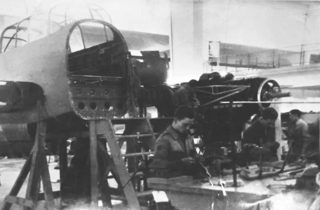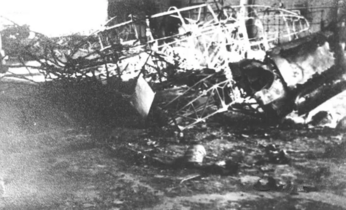Varga RMI-1 X/H
| RMI-1 X/H | |
|---|---|

| |
| Role | Fighter-bomber/Reconnaissance aircraft |
| National origin | Hungary |
| Manufacturer | Repülő Muszaki Intézet (RMI) |
| Designer | László Varga |
| First flight | Undertook taxiing trials and high speed runs, but was not flown before it was destroyed |
| Primary user | Royal Hungarian Air Force (MKHL) |
| Number built | 1 |
The Varga RMI-1 was a twin-engine
piston engine and purchase the Messerschmitt Me 210 fitted with these engines to fill the fighter-bomber requirement. Due to difficulties with the original engines, the sole prototype was re-engined with German Daimler-Benz DB 605s in 1944 and undertook taxiing trials and high speed runs, but was destroyed by Allied bombing in June 1944 before making its first flight.[2]
Design
The RMI-1 was a low wing, twin-engined aircraft with two turboprop Cs-1 engines slung under the wings. It was designed to have a crew of two or three. The tail section was of the conventional type with a single vertical stabilizer.
Specifications (X/H)
Data from Repülő Muszaki Intézet Varga RMI-1/ X / H[1]
General characteristics
- Length: 12.74 m (41 ft 10 in)
- Wingspan: 15.7 m (51 ft 6 in)
- Height: 5.5 m (18 ft 1 in)
- Empty weight: 4,500 kg (9,921 lb)
- Gross weight: 6,500 kg (14,330 lb)
- Powerplant: 2 × Jendrassik Cs-1 turboprop, 750 kW (1,000 hp) each
Performance
- Maximum speed: 540 km/h (340 mph, 290 kn) estimated
- Varga RMI-1 X/H prototype
-
Varga RMI-1 X/H under construction
-
Varga RMI-1 X H under construction in 1944
-
RMI-1 fighter - bomber in 1944
-
Destroyed RMI-1 prototype
See also
Hungarian military aircraft from the same era
- Weiss Manfréd WM-16 Budapest
- Weiss Manfréd WM-21 Sólyom
- Weiss Manfréd WM-23 Ezüst Nyíl
- MÁVAG Héja
Aircraft of comparable role, configuration, and era
- Bristol Beaufighter
- Focke-Wulf Fw 187 Falke
- Fokker G.I
- Kawasaki Ki-45
- Messerschmitt Bf 110
- Nakajima J1N
- Petlyakov Pe-2
- Potez 630
- PZL.38 Wilk
- Westland Whirlwind
Related lists
- List of aircraft of World War II
- List of aircraft of Hungary in World War II
- List of Hungarian military equipment of World War II
- List of fighter aircraft
- List of bomber aircraft
References
- ^ a b "RMI / Repülő Muszaki Intézet Varga RMI-1/ X / H". Retrieved 7 March 2017.
- ^ "The Jendrassik CS-1: The World's First Turboprop Engine". www.tailsthroughtime.com. Retrieved 2017-03-05.




